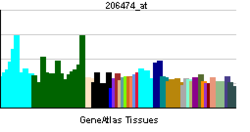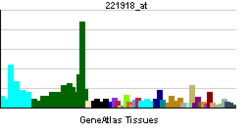- PCTK2
-
Cyclin-dependent kinase 17 Identifiers Symbols CDK17; PCTAIRE2; PCTK2 External IDs OMIM: 603440 MGI: 97517 HomoloGene: 55666 GeneCards: CDK17 Gene EC number 2.7.11.22 Gene Ontology Molecular function • nucleotide binding
• protein kinase activity
• cyclin-dependent protein kinase activity
• ATP bindingBiological process • protein phosphorylation Sources: Amigo / QuickGO RNA expression pattern 

More reference expression data Orthologs Species Human Mouse Entrez 5128 237459 Ensembl ENSG00000059758 ENSMUSG00000020015 UniProt Q00537 Q5RKZ8 RefSeq (mRNA) NM_001170464.2 NM_146239.2 RefSeq (protein) NP_001163935.1 NP_666351.2 Location (UCSC) Chr 12:
96.67 – 96.79 MbChr 10:
92.62 – 92.73 MbPubMed search [1] [2] Serine/threonine-protein kinase PCTAIRE-2 is an enzyme that in humans is encoded by the PCTK2 gene.[1][2]
The protein encoded by this gene belongs to the cdc2/cdkx subfamily of the ser/thr family of protein kinases. It has similarity to rat protein which is thought to play a role in terminally differentiated neurons.[2]
References
- ^ Hirose T, Tamaru T, Okumura N, Nagai K, Okada M (Dec 1997). "PCTAIRE 2, a Cdc2-related serine/threonine kinase, is predominantly expressed in terminally differentiated neurons". Eur J Biochem 249 (2): 481–8. doi:10.1111/j.1432-1033.1997.t01-1-00481.x. PMID 9370357.
- ^ a b "Entrez Gene: PCTK2 PCTAIRE protein kinase 2". http://www.ncbi.nlm.nih.gov/sites/entrez?Db=gene&Cmd=ShowDetailView&TermToSearch=5128.
Further reading
- Meyerson M, Enders GH, Wu CL et al. (1992). "A family of human cdc2-related protein kinases". EMBO J. 11 (8): 2909–17. PMC 556772. PMID 1639063. http://www.pubmedcentral.nih.gov/articlerender.fcgi?tool=pmcentrez&artid=556772.
- Hirose T, Kawabuchi M, Tamaru T et al. (2000). "Identification of tudor repeat associator with PCTAIRE 2 (Trap). A novel protein that interacts with the N-terminal domain of PCTAIRE 2 in rat brain". Eur. J. Biochem. 267 (7): 2113–21. doi:10.1046/j.1432-1327.2000.01218.x. PMID 10727952.
- Yamochi T, Nishimoto I, Okuda T, Matsuoka M (2001). "ik3-1/Cables is associated with Trap and Pctaire2". Biochem. Biophys. Res. Commun. 286 (5): 1045–50. doi:10.1006/bbrc.2001.5493. PMID 11527406.
- Strausberg RL, Feingold EA, Grouse LH et al. (2003). "Generation and initial analysis of more than 15,000 full-length human and mouse cDNA sequences". Proc. Natl. Acad. Sci. U.S.A. 99 (26): 16899–903. doi:10.1073/pnas.242603899. PMC 139241. PMID 12477932. http://www.pubmedcentral.nih.gov/articlerender.fcgi?tool=pmcentrez&artid=139241.
- Conte N, Delaval B, Ginestier C et al. (2003). "TACC1-chTOG-Aurora A protein complex in breast cancer". Oncogene 22 (50): 8102–16. doi:10.1038/sj.onc.1206972. PMID 14603251.
- Jin J, Smith FD, Stark C et al. (2004). "Proteomic, functional, and domain-based analysis of in vivo 14-3-3 binding proteins involved in cytoskeletal regulation and cellular organization". Curr. Biol. 14 (16): 1436–50. doi:10.1016/j.cub.2004.07.051. PMID 15324660.
- Gerhard DS, Wagner L, Feingold EA et al. (2004). "The status, quality, and expansion of the NIH full-length cDNA project: the Mammalian Gene Collection (MGC)". Genome Res. 14 (10B): 2121–7. doi:10.1101/gr.2596504. PMC 528928. PMID 15489334. http://www.pubmedcentral.nih.gov/articlerender.fcgi?tool=pmcentrez&artid=528928.
- Barrios-Rodiles M, Brown KR, Ozdamar B et al. (2005). "High-throughput mapping of a dynamic signaling network in mammalian cells". Science 307 (5715): 1621–5. doi:10.1126/science.1105776. PMID 15761153.
- Rual JF, Venkatesan K, Hao T et al. (2005). "Towards a proteome-scale map of the human protein-protein interaction network". Nature 437 (7062): 1173–8. doi:10.1038/nature04209. PMID 16189514.
- Wissing J, Jänsch L, Nimtz M et al. (2007). "Proteomics analysis of protein kinases by target class-selective prefractionation and tandem mass spectrometry". Mol. Cell Proteomics 6 (3): 537–47. doi:10.1074/mcp.T600062-MCP200. PMID 17192257.
Categories:- Human proteins
- Chromosome 12 gene stubs
Wikimedia Foundation. 2010.
